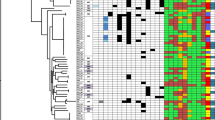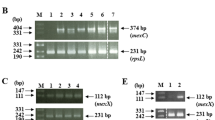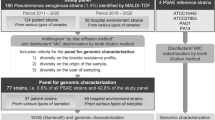Abstract
Pseudomonas aeruginosa is a leading cause of hospital-acquired infections and difficult to treat due to acquired-resistance to multiple antibiotics. A pair of strains, M38100A and M38100B, previously identified from a single clinical isolate of P. aeruginosa was investigated to understand phenotypic and genotypic characteristics. Results revealed that the pair of strains was very similar for serum susceptibility, growth rate in a complex medium (Luria–Bertani), RAPD-genotype profiles, status of genes encoding type III secretion toxins, and no extra-chromosomal DNA. However, antibiotic susceptibility of the strain M38100B showed resistant to all tested-antibiotics while the strain M38100A showed susceptible to the same tested-antibiotics as similar levels of P. aeruginosa PAO1. The strain M38100B exhibited no growth in a minimal medium as a sole carbon and nitrogen source of glutamate while the strain M38100A grew well in the same minimal medium. These results suggest that multidrug resistance of the strain M38100B may be caused by multiple mutations on its genomic DNA and a precursor stage for a homogeneous multidrug resistant population.




Similar content being viewed by others
References
Rowe SM, Miller S, Sorscher EJ (2005) Cystic fibrosis. N Engl J Med 352(19):1992–2001
Driscoll JA, Brody SL, Kollef MH (2007) The epidemiology, pathogenesis and treatment of Pseudomonas aeruginosa infections. Drugs 67(3):351–368
Hancock RE, Speert DP (2000) Antibiotic resistance in Pseudomonas aeruginosa: mechanisms and impact on treatment. Drug Resist Updat 3(4):247–255
Poole K (2005) Efflux-mediated antimicrobial resistance. J Antimicrob Chemother 56(1):20–51
Mulvey MR, Simor AE (2009) Antimicrobial resistance in hospitals: how concerned should we be? CMAJ 180(4):408–415
Llobet E, Tomas JM, Bengoechea JA (2008) Capsule polysaccharide is a bacterial decoy for antimicrobial peptides. Microbiology 154(Pt 12):3877–3886
Jalal S, Wretlind B (1998) Mechanisms of quinolone resistance in clinical strains of Pseudomonas aeruginosa. Microb Drug Resist 4(4):257–261
Falagas ME, Makris GC, Dimopoulos G, Matthaiou DK (2008) Heteroresistance: a concern of increasing clinical significance? Clin Microbiol Infect 14(2):101–104
Maor Y, Hagin M, Belausov N, Keller N, Ben-David D, Rahav G (2009) Clinical features of heteroresistant vancomycin-intermediate Staphylococcus aureus bacteremia versus those of methicillin-resistant S. aureus bacteremia. J Infect Dis 199(5):619–624
D’Mello D, Daley AJ, Rahman MS, Qu Y, Garland S, Pearce C et al (2008) Vancomycin heteroresistance in bloodstream isolates of Staphylococcus capitis. J Clin Microbiol 46(9):3124–3126
Li J, Rayner CR, Nation RL, Owen RJ, Spelman D, Tan KE et al (2006) Heteroresistance to colistin in multidrug-resistant Acinetobacter baumannii. Antimicrob Agents Chemother 50(9):2946–2950
Rinder H, Mieskes KT, Loscher T (2001) Heteroresistance in Mycobacterium tuberculosis. Int J Tuberc Lung Dis 5(4):339–345
Morand B, Muhlemann K (2007) Heteroresistance to penicillin in Streptococcus pneumoniae. Proc Natl Acad Sci USA 104(35):14098–14103
Alam MR, Donabedian S, Brown W, Gordon J, Chow JW, Zervos MJ et al (2001) Heteroresistance to vancomycin in Enterococcus faecium. J Clin Microbiol 39(9):3379–3381
Yamazumi T, Pfaller MA, Messer SA, Houston AK, Boyken L, Hollis RJ et al (2003) Characterization of heteroresistance to fluconazole among clinical isolates of Cryptococcus neoformans. J Clin Microbiol 41(1):267–272
Kwon DH, Lu CD (2007) Polyamine effects on antibiotic susceptibility in bacteria. Antimicrob Agents Chemother 51(6):2070–2077
Lu CD, Itoh Y, Nakada Y, Jiang Y (2002) Functional analysis and regulation of the divergent spuABCDEFGH-spuI operons for polyamine uptake and utilization in Pseudomonas aeruginosa PAO1. J Bacteriol 184(14):3765–3773
Mahenthiralingam E, Campbell ME, Foster J, Lam JS, Speert DP (1996) Random amplified polymorphic DNA typing of Pseudomonas aeruginosa isolates recovered from patients with cystic fibrosis. J Clin Microbiol 34(5):1129–1135
Ajayi T, Allmond LR, Sawa T, Wiener-Kronish JP (2003) Single-nucleotide-polymorphism mapping of the Pseudomonas aeruginosa type III secretion toxins for development of a diagnostic multiplex PCR system. J Clin Microbiol 41(8):3526–3531
Kwon DH, Lu CD (2006) Polyamines induce resistance to cationic peptide, aminoglycoside, and quinolone antibiotics in Pseudomonas aeruginosa PAO1. Antimicrob Agents Chemother 50(5):1615–1622
Falagas ME, Koletsi PK, Bliziotis IA (2006) The diversity of definitions of multidrug-resistant (MDR) and pandrug-resistant (PDR) Acinetobacter baumannii and Pseudomonas aeruginosa. J Med Microbiol 55(Pt 12):1619–1629
Falagas ME, Bliziotis IA (2007) Pandrug-resistant Gram-negative bacteria: the dawn of the post-antibiotic era? Int J Antimicrob Agents 29(6):630–636
Falagas ME, Rafailidis PI, Matthaiou DK, Virtzili S, Nikita D, Michalopoulos A (2008) Pandrug-resistant Klebsiella pneumoniae, Pseudomonas aeruginosa and Acinetobacter baumannii infections: characteristics and outcome in a series of 28 patients. Int J Antimicrob Agents 32(5):450–454
Wang CY, Jerng JS, Chen KY, Lee LN, Yu CJ, Hsueh PR et al (2006) Pandrug-resistant Pseudomonas aeruginosa among hospitalised patients: clinical features, risk-factors and outcomes. Clin Microbiol Infect 12(1):63–68
Henrichfreise B, Wiegand I, Pfister W, Wiedemann B (2007) Resistance mechanisms of multiresistant Pseudomonas aeruginosa strains from Germany and correlation with hypermutation. Antimicrob Agents Chemother 51(11):4062–4070
Oliver A, Canton R, Campo P, Baquero F, Blazquez J (2000) High frequency of hypermutable Pseudomonas aeruginosa in cystic fibrosis lung infection. Science 288(5469):1251–1254
Mena A, Smith EE, Burns JL, Speert DP, Moskowitz SM, Perez JL et al (2008) Genetic adaptation of Pseudomonas aeruginosa to the airways of cystic fibrosis patients is catalyzed by hypermutation. J Bacteriol 190(24):7910–7917
Macia MD, Blanquer D, Togores B, Sauleda J, Perez JL, Oliver A (2005) Hypermutation is a key factor in development of multiple-antimicrobial resistance in Pseudomonas aeruginosa strains causing chronic lung infections. Antimicrob Agents Chemother 49(8):3382–3386
Juan C, Macia MD, Gutierrez O, Vidal C, Perez JL, Oliver A (2005) Molecular mechanisms of beta-lactam resistance mediated by AmpC hyperproduction in Pseudomonas aeruginosa clinical strains. Antimicrob Agents Chemother 49(11):4733–4738
Livermore DM (2002) Multiple mechanisms of antimicrobial resistance in Pseudomonas aeruginosa: our worst nightmare? Clin Infect Dis 34(5):634–640
Girlich D, Naas T, Leelaporn A, Poirel L, Fennewald M, Nordmann P (2002) Nosocomial spread of the integron-located veb-1-like cassette encoding an extended-spectrum beta-lactamase in Pseudomonas aeruginosa in Thailand. Clin Infect Dis 34(5):603–611
Kwon DH, Versalovic J (2009) Fur-independent induction of Helicobacter pylori flavodoxin-encoding gene (fldA) under iron starvation. Helicobacter 14(2):141–146
Author information
Authors and Affiliations
Corresponding author
Rights and permissions
About this article
Cite this article
Mahida, K., Kwon, D.H. Co-Existence of Multidrug-Resistant and -Susceptible Strains of Pseudomonas aeruginosa from a Single Clinical Isolate. Curr Microbiol 61, 19–24 (2010). https://doi.org/10.1007/s00284-009-9570-0
Received:
Accepted:
Published:
Issue Date:
DOI: https://doi.org/10.1007/s00284-009-9570-0




